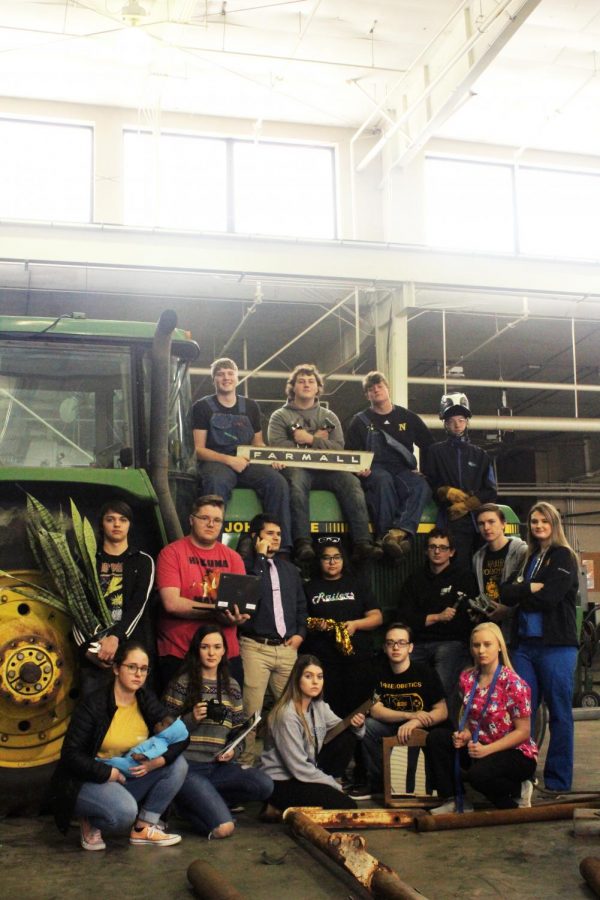The game of life
CTE offers specialized career pathways
More stories from Faye Smith, Addie Lindenmeyer
Cover Photo students Top: Ethan Entz, Nick Koehn, Brett Ashcraft, Dustin Todd Middle Row: Micah Epp, Josh McClure, Matt Seirer, Aliah Ledesma, Jon Fowler, Tristan Meyer, Hannah Becker Bottom Row: Jayden Smith, Emily Brandt, Emma Nelson, Ash Gibson, Jessica Floreke
Walking into Newton High School, bright-eyed and bushy tailed, eighth grade students received the rundown of all Career and Technical Education (CTE) courses that the school has to offer. Although, odds are, their knowledge of the CTE program stops there, ceasing with the awareness of courses and leaving the opportunities provided by the CTE program a mere fantasy.
Originating as Vocational Tech (Vo-Tech), Rangel credits the evolution of the CTE program to her predecessor Jonelle Lucas. By partnering with Hutchinson Community College (HCC) early in the program’s creation, the school received money from capital outlay for funding.
“The intent is for all of our pathways, whether it’s manufacturing or AV communications, which was what you guys are all in, is that students will learn enough about a career field to help them make informed decisions about post secondary choices, whether it’s college or career or anything in between,” Rangel said.
With post secondary choices in mind, the school offers a range of 18 CTE programs, ranging anywhere from agricultural to business and even the medical fields. Rangel believes that location as well as the partnership with HCC have played a large role in the widespread impact of the program.
Rangel said that students participating in a career pathway will graduate with the skill set to them move into entry level employment. Through the CTE program, students can earn certifications and receive internships, getting hands-on experience before entering the career field.
“I think college is awesome. I mean, I’m a college graduate my kids are but it’s not for every kid,” Rangel said. “Not every kid at Newton High School is going to go to college, right? But I would say CTE is for every kid, college or not because you’ll have some great skills.”
Career and Technical Student Organizations (CTSO) provide avenues for students looking to practice skills such as communication, teamwork, leadership. CTSO participants, compete in events using practical application skills being taught in a designated pathway.
“For example, in manufacturing, they do SkillsUSA. So they went and they had a manufacturing issue that they had to solve. They had to fix a part or replace a part, Rangel said. “Auto goes to the Pratt Olympics at Pratt College and has a problem with a car that they solve. Some of them are paper pencil tests, some of them are hands-on tests.”
Due to the abundant amount of pathway offerings and opportunities provided by NHS, the school welcomes students from surrounding school districts such as Hesston, Maize, Burrton, Canton-Galva, Goessel, Halstead, Hillsboro, Moundridge, Peabody- Burns, Remington, and Sedgwick to participate in CTE pathways and CTSOs not offered at their high school.
“Those areas schools, they come to us because they are small compared to our district and they don’t have the facilities that we have. Take manufacturing, for example, not very many schools are going to have all that equipment that we have at Brooks,” Rangel said. “It’s much cheaper for them to send their kids to us as opposed to going and building a building like that and putting all that equipment in the thing that provides those areas.”
Woodworking and laserworks teacher Rusty Jolliff provides students with the skills to design and construct products from start to finish. Jolliff helps to better prepare students to go into the pathway of construction, a broad area, involving everything from concrete, steelwork, drywall and brick laying.
“We say we’re the hands-on activity, but it’s more than just the tools. You have to have the design as well,” Jolliff said. “They take what they learn in other classes and apply that here. Specifically construction, furniture, cabinet making, any of that stuff applies.”
Within each career pathway, students take three levels of courses, including introductory, technical and application. Each course requires a set of competencies to be completed in order to continue in the pathway.
“My students benefit from the [CTE classes] because they do get the hands-on experience my industry’s looking for. We do competencies that we fill out for each student. Higher the class, the more competencies you have to meet. We go through and check those off,” Jolliff said.
Senior Reid Graber has been involved in the CTE programs for the past two years, participating in Robotics and the Engineering Design and Development (EDD) course. Graber said not only does involvement in the CTE program look good on paper, but Graber said it has managed to acquire him multiple college interviews.
“I think because it [CTE courses] gives students the hands-on experience they need in the work field,” Graber said.
Not only has the CTE managed to assist students in making and excelling in postsecondary choices, but Rangel believes it has motivated some students in finding a passion.
“I am thinking of a couple of kids and if it wasn’t for their CTE class, they probably wouldn’t be hanging around any more. They know they’re not going to go into any post secondary education, but they know that this field that they’re going to get in this particular manufacturing pathway is going to set them up for success,” Rangel said. “So when they do leave, they know they are employable and they have a good job waiting on them.”

